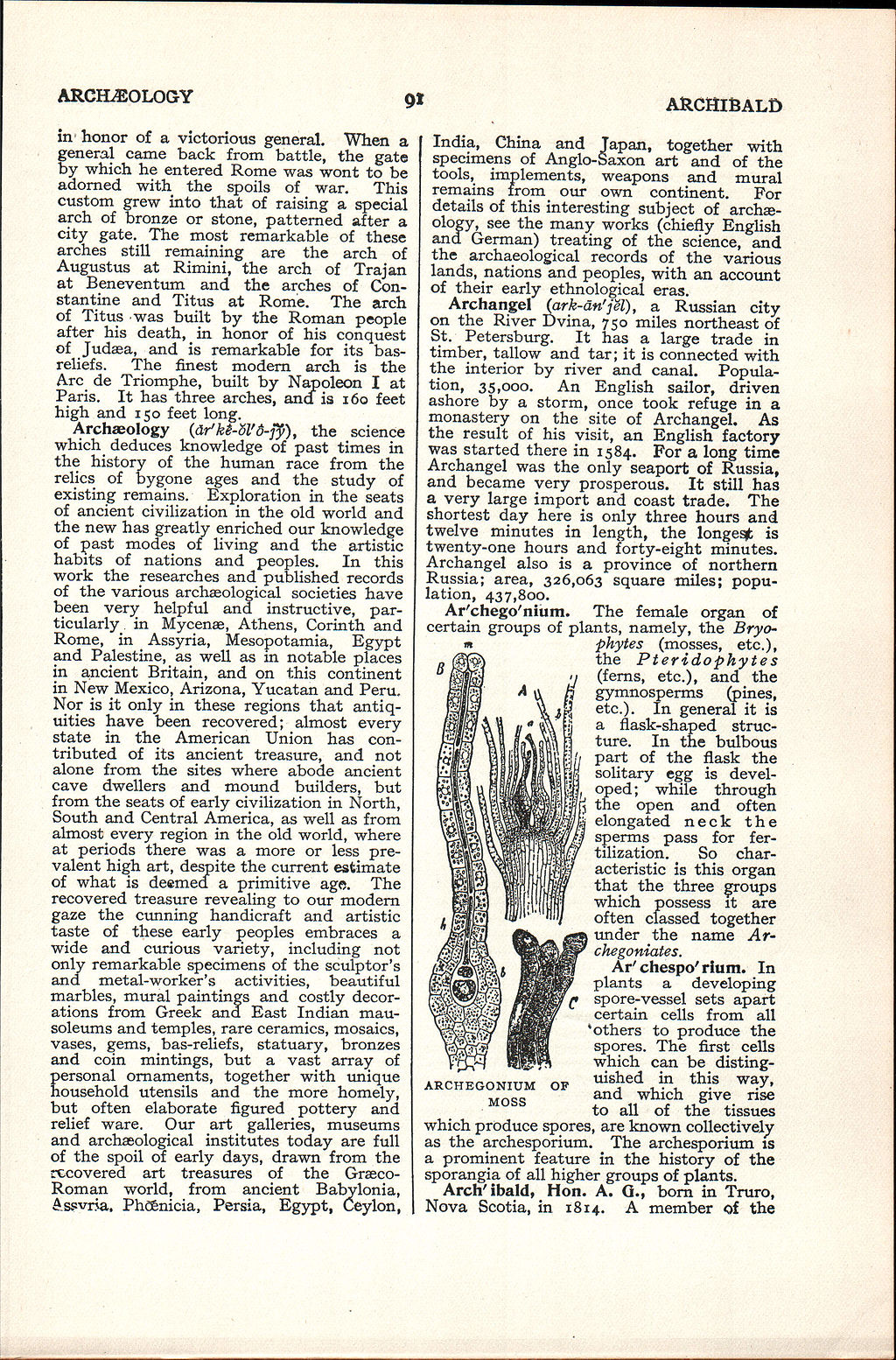Page 91 : ARCHÆOLOGY — ARCHIBALD
Individual articles:
in honor of a victorious general. When a general came back from battle, the gate by which he entered Rome was wont to be adorned with the spoils of war. This custom grew into that of raising a special arch of bronze or stone, patterned after a city gate. The most remarkable of these arches still remaining are the arch of Augustus at Rimini, the arch of Trajan at Beneventum and the arches of Constantine and Titus at Rome. The arch of Titus was built by the Roman people after his death, in honor of his conquest of Judaea, and is remarkable for its bas-reliefs. The finest modern arch is the Arc de Triomphe, built by Napoleon I at Paris. It has three arches, and is 160 feet high and 150 feet long.
Archæology (är′kē-ŏl′ō-jy̆) the science which deduces knowledge of past times in the history of the human race from the relics of Bygone ages and the study of existing remains. Exploration in the seats of ancient civilization in the old world and the new has greatly enriched our knowledge of past modes of living and the artistic habits of nations and peoples. In this work the researches and published records of the various archælogical societies have been very helpful and instructive, particularly in Mycenae, Athens, Corinth and Rome, in Assyria, Mesopotamia, Egypt and Palestine, as well as in notable places in ancient Britain, and on this continent in New Mexico, Arizona, Yucatan and Peru. Nor is it only in these regions that antiquities have been recovered; almost every state in the American Union has contributed of its ancient treasure, and not alone from the sites where abode ancient cave dwellers and mound builders, but from the seats of early civilization in North, South and Central America, as well as from almost every region in the old world, where at periods there was a more or less prevalent high art, despite the current estimate of what is deemed a primitive age. The recovered treasure revealing to our modern gaze the cunning handicraft and artistic taste of these early peoples embraces a wide and curious variety, including not only remarkable specimens of the sculptor's and metal-worker's activities, beautiful marbles, mural paintings and costly decorations from Greek and East Indian mausoleums and temples, rare ceramics, mosaics, vases, gems, bas-reliefs, statuary, bronzes and coin mintings, but a vast array of personal ornaments, together with unique household utensils and the more homely, but often elaborate figured pottery and relief ware. Our art galleries, museums and archæological institutes today are full of the spoil of early days, drawn from the recovered art treasures of the Græco-Roman world, from ancient Babylonia, Assvria. Phœnicia, Persia, Egypt, Ceylon, India, China and Japan, together with specimens of Anglo-Saxon art and of the tools, implements, weapons and mural remains from our own continent. For details of this interesting subject of archæology, see the many works (chiefly English and German) treating of the science, and the archaeological records of the various lands, nations and peoples, with an account of their early ethnological eras.
Archangel (ark-ān′jĕl), a Russian city on the River Dvina, 750 miles northeast of St. Petersburg. It has a large trade in timber, tallow and tar; it is connected with the interior by river and canal. Population, 35,000. An English sailor, driven ashore by a storm, once took refuge in a monastery on the site of Archangel. As the result of his visit, an English factory was started there in 1584. For a long time Archangel was the only seaport of Russia, and became very prosperous. It still has a very large import and coast trade. The shortest day here is only three hours and twelve minutes in length, the longest is twenty-one hours and forty-eight minutes. Archangel also is a province of northern Russia; area, 326,063 square miles; population, 437,800.
Ar′chego′nium. The female organ of certain groups of plants, namely, the Bryophytes (mosses, etc.), the Pteridophytes (ferns, etc.), and the gymnosperms (pines, etc.). In general it is a flask-shaped structure. In the bulbous part of the flask the solitary egg is developed; while through the open and often elongated neck the sperms pass for fertilization. So characteristic is this organ that the three groups which possess it are often classed together under the name Archegoniates.
ARCHEGONIUM OF MOSS
Ar′chespo′rium. In plants a developing spore-vessel sets apart certain cells from all others to produce the spores. The first cells which can be distinguished in this way, and which give rise to all of the tissues which produce spores, are known collectively as the archesporium. The archesporium is a prominent feature in the history of the sporangia of all higher groups of plants.
Arch′ibald, Hon. A. G. born in Truro, Nova Scotia, in 1814. A member of the
